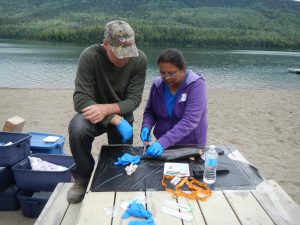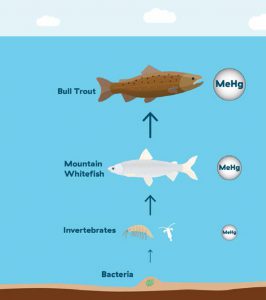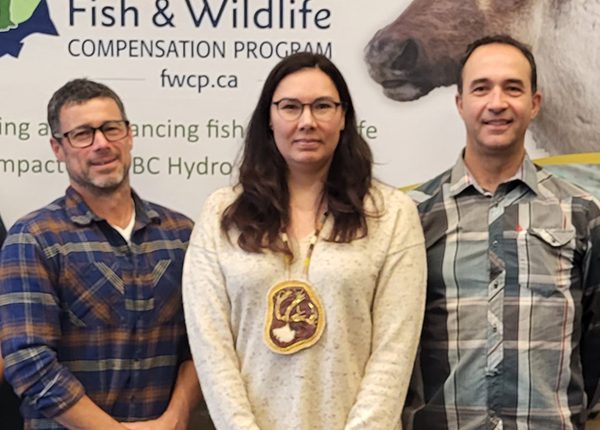Study results: methylmercury levels in fish
Through our work with Indigenous Nations and local communities, we’ve heard concerns about how reservoir creation on the Peace River system has affected methylmercury levels in fish. That’s why the FWCP funded a multi-year study to improve understanding of mercury in fish in all parts of the system. The study involved Indigenous Nations and analyzed tissue samples from more than 1,400 fish.
Study results
The goal of this multi-year study was to improve our understanding of mercury in fish in all parts of the reservoir system, and to provide this information to agencies responsible for advising the public on fish consumption.
Read our concise, plain-language public summary of the three-year mercury study: FWCP Peace Region Mercury Study Public Summary
FWCP Peace Region Mercury Study Final Report (Sept. 2019)
FWCP Peace Region Mercury Study Final Report Appendices (Sept. 2019)
Methylmercury and fish consumption
The Site C project is the third dam on the Peace River and will result in temporary changes in fish methylmercury levels when the new reservoir is filled. Learn more about Site C’s mercury program.
The results of the FWCP’s multi-year study have helped inform current methylmercury levels in Peace River system fish and helped provide safe consumption information.
Read the brochure Methylmercury and fish consumption information in the Peace River system
Watch the video
Background: mercury in fish investigation
Our Peace Region board approved a comprehensive study to collect tissue samples from fish in the Williston and Dinosaur reservoirs and tributaries, in order to measure mercury concentrations. The mercury data collection project started in spring 2016. The final year of sampling was 2018 and the final report was completed in 2019. The results of this study, which was combined with and compared to information collected previously, provides updated information on mercury levels in several fish species in the reservoirs and their tributaries.
Overview of key study results
The FWCP study included tissue mercury data for more than 1,400 fish from the Finlay, Parsnip, and Peace reaches of the Williston Reservoir, Dinosaur Reservoir, and reference lakes and rivers across BC.
The study results focus on areas for which there were sufficient target species data. See study area map on page 3 of the public summary. The levels of mercury in fish measured in the FWCP study are shown in Figure 2 on page 3 of the public summary. See the full study report for more about the study and results.
- The levels of mercury in fish from the Williston Reservoir and its tributaries have declined since the mercury warning was issued and are now similar to levels of mercury in natural lakes and rivers in BC for which there are data.
- In Williston and Dinosaur reservoir watersheds and reference areas predatory fish, such as bull trout and lake trout, have higher levels of mercury than fish lower down on the food chain, such as rainbow trout and kokanee.
- Larger fish have higher mercury levels than smaller fish.
- Current mercury levels in bull trout from the Williston Reservoir are, depending on the size of the fish, about two to six times lower than levels measured between 1980 and 2000. The greatest declines in mercury levels occurred in the largest fish.
- Mercury in fish from the Williston and Dinosaur reservoir watersheds are similar to mercury in fish from natural lakes and rivers in BC for which data were available.
- Mercury in fish from the Williston and Dinosaur reservoir watersheds are lower than the levels of mercury in some types of fish sold in stores and restaurants.
Involvement of Indigenous Nations
This investigation into fish mercury concentrations included many opportunities for direct involvement of Indigenous Nations in the collection of fish samples. Citizens from six Indigenous Nations took part in a training session and learned how to collect fish samples; many participated in collecting fish in areas targeted for sampling; others acted as community coordinators and collected samples during community fishing activities; and some gathered information about fish consumption. Indigenous Nation-led businesses were directly involved or had the opportunity to be involved in the collection of fish samples and worked with the consultants leading this work on behalf of the FWCP.

FWCP involvement
The Fish & Wildlife Compensation Program (FWCP) recognizes that mercury concentrations in fish caught in Williston and Dinosaur reservoir basins are a priority concern for local Indigenous Nations and stakeholders. Our Action Plan for Reservoirs (2014) identifies mercury as a high-priority issue and defines objectives, and specific actions to address mercury in our Peace Region. One of those actions is to collaborate with Indigenous Nations and liaise with appropriate agencies in implementing a study to investigate mercury concentrations in fish for Williston-Dinosaur basins.
Our Peace Region board selected Azimuth Consulting Group Partnership (Azimuth) to conduct this multi-year investigation to study mercury.
Our role is to facilitate dialogue among partners, including engagement with Indigenous Nations, and oversee the scientific collection of relevant data. We do not have a mandate to specifically address human health issues related to fish consumption. We are committed to working with others in the region to fill information gaps and support a process to provide information to agencies responsible for human health.
Mercury in the environment
Mercury (Hg) is an element of the Earth that is present in low concentrations everywhere in the environment – including in air, water, sediment, soil and in the tissue of all plants and animals. Some of this inorganic mercury is naturally transformed into a potentially more harmful form of mercury called methylmercury.
This transformation process occurs within the cells of bacteria, at the base of the food web, mostly in soil and in sediment of lakes and rivers. Under normal conditions, the natural rate of methylmercury creation is low. However, when a reservoir is formed, bacteria break down and decompose the flooded organic soil very rapidly, creating more methylmercury than under normal conditions until the flooded soil is fully broken down and the mercury in the soil runs out.
Once methylmercury has been created by bacteria, it is now part of the food web. Over time in new reservoirs, animals accumulate methylmercury at a greater rate than it can be eliminated from the body, so concentrations increase as animals get older and larger. Animals absorb mercury almost exclusively from their food, with ever increasing concentrations moving up the food chain. Because fish are at the end of a long chain of animals that eat other animals; from small and large invertebrates; and from small fish to large and carnivorous fish, methylmercury is always higher in fish than other animals. Furthermore, the concentration of methylmercury is always highest in large and old fish, especially those species at the top of the food chain such as lake trout, bull trout, northern pike, and walleye.

Mercury and methylmercury are present in other animals we consume, such as chicken, beef, deer, and moose but in much lower amounts than fish, because these animals only eat plants, which are always low in mercury. Since the amount of mercury varies by fish species, size and age, it is important to measure mercury levels in fish from across the spectrum of species, sizes and ages.
Once the mercury present in the rotting, flooded organic soil runs out, mercury concentrations in fish slowly decline. Thus, fish mercury concentrations return to a new baseline level between 20 and 30 years after reservoir creation.
Mercury concentrations in fish are reported in units of “parts per million” (ppm). In British Columbia, typical fish mercury concentrations range from less than 0.10 up to 1.0 ppm. By comparison, the mercury concentration in tinned tuna or store-bought halibut ranges from 0.15 to >0.30 ppm. Wild salmon normally have very low concentrations (<0.10 ppm), while other less commonly consumed species like marlin or swordfish can be higher (1 – 2 ppm). It is also important to realize that on their own, concentration data are not that meaningful. It is the “dose” that is important, which is a combination of fish mercury concentration and how often and how much fish are consumed over time by an individual.
Williston and Dinosaur basins. The goal is to improve our understanding of mercury in fish in all parts of the reservoir system, and to provide this information to agencies responsible for advising the public on fish consumption so that they have enough information to consider in developing any potential revised mercury public advisory.





